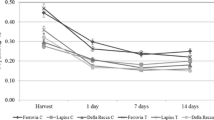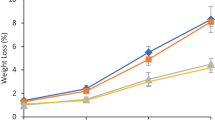Abstract
In this study, sweet cherries were coated with four chitosans (1%) [two of them produced from shrimp waste from Marmara Sea in Turkey (Chitosan-1, Chitosan-2) and two of them commercially produced (Commercial-1 and Commercial-2)] which have different deacetylation degree, and molecular weight (Chitosan-1, deacetylation degree: 78.20%, molecular weight: 182 kDa; Chitosan-2, deacetylation degree: 84.95%, molecular weight: 127 kDa; Commercial-1, deacetylation degree: 81.22%, molecular weight: 273 kDa; Commercial-2, deacetylation degree: 75.12%, molecular weight: 407 kDa) and stored at 4 °C for 25 days, and 20 °C for 15 days. Changes in the total phenolic content, antioxidant capacity, total anthocyanin content, ascorbic acid, total pectin content, firmness, and colour values were evaluated. The results revealed that Chitosan-1 had the highest firmness value; Chitosan-2 showed the highest total anthocyanin and total phenolic content and Commercial-1 exhibited the highest antioxidant capacity and ascorbic acid content at 4 °C. Furthermore, it was found that Chitosan-1 demonstrated the highest total phenolic content; Chitosan-2 displayed the highest total anthocyanin; Commercial-1 had the highest firmness value and C-2 exhibited the highest ascorbic acid content at 20 °C. In conclusion, each tested chitosan coatings have different effects on different quality attributes at different storage temperatures.

Similar content being viewed by others
References
Aday M.S. (2008). The Effect of Various Edible Coatings on Cherry Quality and Consumer Perception Based on Kinetics Model Evaluation. (Master thesis). Çanakkale Onsekiz Mart University.
Aday MS, Caner C (2010) Understanding the effects of various edible coatings on the storability of fresh cherry. Packag Technol Sci 23(8):441–456
Anonymous (1968) IFJU, Methods of Analyses. Method-26, Pectin. International Federation of Fruit Juice Procedures, 10, Rue de Liege, Paris, France
Baldwin EA, Hagenmaier R, Bai J (2009) Edible coatings and films to improve food quality. In: Bai J, Plotto A (eds) Coatings for fresh fruits and vegetables, 3rd edn. Technomic Publ. Co., India, pp 186–226
Cemeroğlu B, Yemenicioğlu A, Özkan M (2001) Meyve ve sebzelerin bileşimi, soğukta depolanmaları. Gıda teknolojisi derneği yayınları, Ankara
Çetin A.C. (2012). Effects of edible chitosan coating on quality parameters of pomegranate (Punıca granatum) arils. (Master thesis). Middle East Technical University.
Chiabrando V, Giacalone G (2015) Effects of alginate edible coating on quality and antioxidant properties in sweet cherry during postharvest storage. Ital J Food Sci 27(2):173
Chien PJ, Sheu F, Yang FH (2007) Effects of edible chitosan coating on quality and shelf life of sliced mango fruit. J Food Eng 78(1):225–229
Cho YI, No HK, Meyers SP (1998) Physicochemical characteristics and functional properties of various commercial chitin and chitosan products. J Agri Food Chem 46(9):3839–3843
Dang QF, Yan JQ, Li Y, Cheng XJ, Liu CS, Chen XG (2010) Chitosan acetate as an active coating material and its effects on the storing of Prunus avium L. J Food Sci 75(2):S125–S131
Debeaufort F, Quezada-Gallo JA, Voilley A (1998) Edible films and coatings: tomorrow's packagings: a review. Crit Rev Food Science 38(4):299–313
Díaz-Mula HM, Serrano M, Valero D (2012) Alginate coatings preserve fruit quality and bioactive compounds during storage of sweet cherry fruit. Food Bioprocess Technol 5(8):2990–2997
Dutta PK, Tripathi S, Mehrotra GK, Dutta J (2009) Perspectives for chitosan based antimicrobial films in food applications. Food Chem 114(4):1173–1182
Ferretti G, Bacchetti T, Belleggia A, Neri D (2010) Cherry antioxidants: from farm to table. Molecules 15(10):6993–7005
Franke SIR, Ckless K, Silveira JD, Rubensam G, Brendel M, Erdtmann B et al (2004) Study of antioxidant and mutagenic activity of different orange juices. Food Chem 88(1):45–55
Fuleki T, Francis FJ (1968) Quantitative methods for anthocyanins. 1. extraction and determination of total anthocyanin in cranberries. J Food Sci 33(1):72–77
Ghasemnezhad M, Zareh S, Rassa M, Sajedi RH (2013) Effect of chitosan coating on maintenance of aril quality, microbial population and PPO activity of pomegranate (Punica granatum L. cv. Tarom) at cold storage temperature. J Sci Food Agri 93(2):368–374
Gonçalves B, Landbo AK, Knudsen D, Silva AP, Moutinho-Pereira J, Rosa E et al (2004) Effect of ripeness and postharvest storage on the phenolic profiles of cherries (Prunus avium L.). J Agri Chem 52(3):523–530
Han C, Zuo J, Wang Q, Xu L, Zhai B, Wang Z et al (2014) Effects of chitosan coating on postharvest quality and shelf life of sponge gourd (Luffa cylindrica) during storage. Sci Hortic 166:1–8
Hışıl Y (2004) Enstrümental gıda analizleri-laboratuar deneyleri. Ege Üniversitesi Mühendislik Fakültesi Ders Kitapları Yayın no:45, Bornova, İzmir, p 39
Hossain MS, Iqbal A (2014) Production and characterization of chitosan from shrimp waste. J Bangladesh Agri Univ 12(1):153–160
Kamil JY, Jeon YJ, Shahidi F (2002) Antioxidative activity of chitosans of different viscosity in cooked comminuted flesh of herring (Clupea harengus). Food Chem 79(1):69–77
Kalt W, Forney CF, Martin A, Prior RL (1999) Antioxidant capacity, vitamin C, phenolics, and anthocyanins after fresh storage of small fruits. J Agri Food Chem 47(11):4638–4644
Kelebek H, Selli S (2011) Evaluation of chemical constituents and antioxidant activity of sweet cherry (Prunus avium L.) cultivars. Int J Food Sci Technol 46(12):2530–2537
Kerch G, Sabovics M, Kruma Z, Kampuse S, Straumite E (2011) Effect of chitosan and chitooligosaccharide on vitamin C and polyphenols contents in cherries and strawberries during refrigerated storage. Eur Food Res Technol 233(2):351–358
Kim KW, Thomas RL (2007) Antioxidative activity of chitosans with varying molecular weights. Food Chem 101(1):308–313
Matsugo S, Mizuie M, Matsugo M, Ohwa R, Kitano H, Konishi T (1998) Synthesis and antioxidant activity of water soluble chitosan derivatives. IUBMB Life 44(5):939–948
Mikkelsen BB, Poll L (2002) Decomposition and transformation of aroma compounds and anthocyanins during black currant (Ribes nigrum L.) juice processing. J Food Sci 67:3447–3451
Mozetic B, Trebse P (2004) Identification of sweet cherry anthocyanins and hydroxycinnamic acids using HPLC coupled with DAD and MS detector. Acta Chim Slov 51(1):151–158
Mulabagal V, Lang GA, DeWitt DL, Dalavoy SS, Nair MG (2009) Anthocyanin content, lipid peroxidation and cyclooxygenase enzyme inhibitory activities of sweet and sour cherries. J Agri Food Chem 57(4):1239–1246
Nabifarkhani N, Sharifani M, Daraei GA, Ganji ME, Shakeri A (2015) Effect of nano composite and Thyme oil (Tymus Vulgaris L) coating on fruit quality of sweet cherry (Takdaneh Cv) during storage period. Food Sci Nutr 3(4):349–354
Nair MS, Saxena A, Kaur C (2018) Effect of chitosan and alginate based coatings enriched with pomegranate peel extract to extend the postharvest quality of guava (Psidium Guajava L.). Food Chem 240:245–252
Pappas CS, Takidelli C, Tsantili E, Tarantilis PA, Polissiou MG (2011) Quantitative determination of anthocyanins in three sweet cherry varieties using diffuse reflectance infrared Fourier transform spectroscopy. J Food Compos Anal 24(1):17–21
Park PJ, Je JY, Kim SK (2004) Free radical scavenging activities of differently deacetylated chitosans using an ESR spectrometer. Carbohyd Polym 55(1):17–22
Petriccione M, De Sanctis F, Pasquariello MS, Mastrobuoni F, Rega P, Scortichini M, Mencarelli F (2015) The effect of chitosan coating on the quality and nutraceutical traits of sweet cherry during postharvest life. Food Bioprocess Technol 8(2):394–408
Prvulović D, Malenčić D, Popović M, Ljubojević M, Ognjanov V (2011) Antioxidant properties of sweet cherries (Prunus avium L.)-Role of phenolic compounds. World Acad Sci Eng Technol 59:1149–1152
Raafat D, Sahl HG (2009) Chitosan and its antimicrobial potential–a critical literature survey. Microb Biotechnol 2(2):186–201
Rajalakshmi A, Krithiga N, Jayachitra A (2013) Antioxidant activity of the chitosan extracted from shrimp exoskeleton. Middle-East J Sci Res 16(10):1446–1451
Re R, Pellegrini N, Proteggente A, Pannala A, Yang M, Rice-Evans C (1999) Antioxidant activity applying an improved ABTS radical cation decolorization assay. Free Radic Biol Med 26(9–10):1231–1237
Reyes-Avalos MC, Minjares-Fuentes R, Femenia A, Contreras-Esquivel JC, Quintero-Ramos A, Esparza-Rivera JR et al (2019) Application of an alginate-chitosan edible film on figs (Ficus carica): effect on bioactive compounds and antioxidant capacity. Food Bioprocess Technol 12(3):499–511
Samar MM, El-Kalyoubi MH, Khalaf MM, El-Razik MA (2013) Physicochemical, functional, antioxidant and antibacterial properties of chitosan extracted from shrimp wastes by microwave technique. Ann Agri Sci 58(1):33–41
Shiri MA, Bakhshi D, Ghasemnezhad M, Dadi M, Papachatzis A, Kalorizou H (2013) Chitosan coating improves the shelf life and postharvest quality of table grape (Vitis vinifera) cultivar Shahroudi. Turk J Agri For 37(2):148–156
Tokatlı K, Demirdöven A (2018) Optimization of chitin and chitosan production from shrimp wastes and characterization. J Food Process Preserv 42(2):e13494
Tokatlı K, Demirdöven A (2020) Effects of chitosan edible film coatings on the physicochemical and microbiological qualities of sweet cherry (Prunus avium L.). Scientia Hortic 259:108656
Tolaimate A, Desbrieres J, Rhazi M, Alagui A, Vincendon M, Vottero P (2000) On the influence of deacetylation process on the physicochemical characteristics of chitosan from squid chitin. Polymer 41(7):2463–2469
Trung ST, Bao HND (2015) Physicochemical properties and antioxidant activity of chitin and chitosan prepared from pacific white shrimp waste. Int J Carbohydr Chem 2015:706259
Vinsova J, Vavrikova E (2011) Chitosan derivatives with antimicrobial, antitumour and antioxidant activities-a review. Curr Pharm Des 17(32):3596–3607
Wan A, Xu Q, Sun Y, Li H (2013) Antioxidant activity of high molecular weight chitosan and N, O-quaternized chitosans. J Agri Food Chem 61(28):6921–6928
Wani AA, Singh P, Gul K, Wani MH, Langowski HC (2014) Sweet cherry (Prunus avium): Critical factors affecting the composition and shelf life. Food Packag Shelf Life 1(1):86–99
Yaman Ö, Bayoιndιrlι L (2002) Effects of an edible coating and cold storage on shelf-life and quality of cherries. LWT-Food Sci Technol 35(2):146–150
Yen MT, Tseng YH, Li RC, Mau JL (2007) Antioxidant properties of fungal chitosan from shiitake stipes. LWT-Food Sci Technol 40(2):255–261
Zam W (2019) Effect of alginate and chitosan edible coating enriched with olive leaves extract on the shelf life of sweet cherries (Prunus avium L.). J Food Qual. https://doi.org/10.1155/2019/8192964
Author information
Authors and Affiliations
Corresponding author
Additional information
Publisher's Note
Springer Nature remains neutral with regard to jurisdictional claims in published maps and institutional affiliations.
Rights and permissions
About this article
Cite this article
Tokatlı, K., Demirdöven, A. Influences of chitosan coatings on functional compounds of sweet cherries. J Food Sci Technol 58, 1808–1818 (2021). https://doi.org/10.1007/s13197-020-04692-z
Revised:
Accepted:
Published:
Issue Date:
DOI: https://doi.org/10.1007/s13197-020-04692-z




